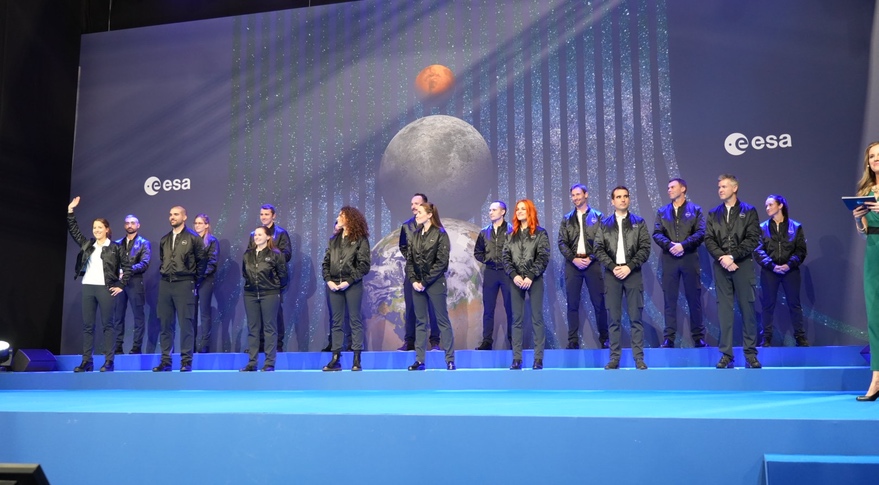PARIS — The European Space Agency has selected its first new astronauts in more than a decade, although long-term flight opportunities for the agency’s astronaut corps remain uncertain.
At an event here immediately after a briefing on the agency’s new three-year budget Nov. 23, ESA announced a class of 17 people it selected as a combination of professional and reserve astronauts, the completion of a selection process that started with more than 22,500 applicants last year. It’s the agency’s first new astronaut class since 2009.
Five of the 17 are “career” astronauts, who will join ESA full-time and start training at the European Astronaut Centre in Cologne, Germany, in April. After completing one year of basic training, they will join ESA’s seven current career astronauts and be eligible for flight assignments.
The five career astronauts are:
- Sophie Adenot, a French helicopter pilot;
- Pablo Álvarez Fernández, a Spanish engineer;
- Rosemary Coogan, a British astrophysicist;
- Raphaël Liégeois, a Belgian neuroscientist; and
- Marco Sieber, a Swiss doctor.
Eleven others were selected as “reserve” astronauts. “They’re not yet engaged by ESA directly though a permanent contract, but they will be available for future astronaut activities” while staying in their current jobs, said ESA Director General Josef Aschbacher.
The final astronaut is John McFall, picked by ESA as part of a “parastronaut” feasibility study to see if people with some physical disabilities could fly in space. McFall, a British doctor, lost his right leg in a motorcycle accident at age 19, but went on to become a Paralympian in track and field.
“Being an astronaut is a very exclusive thing to be, but having a disability shouldn’t rule you out,” said David Parker, ESA’s director of human and robotic exploration, at the event. “We are pioneering something here. It’s something we are really excited to be doing.”
“I felt compelled to help ESA answer this question: can we get someone with a physical disability to do meaningful work in space?” McFall said.
The focus of the feasibility study will be on safety for both the parastronaut as well as his crewmates, said Frank De Winne, head of the European Astronaut Center and himself a former astronaut, in an interview before the astronaut announcement.
“When you have an emergency on the launch pad, you need to be able to evacuate the vehicle in a very short amount of time,” he said. “How can we make sure that the parastronaut can fulfill those requirements together with his crew without endangering himself or his crew?”
The feasibility study, which will include participation by NASA and others, will examine what changes might be needed to the International Space Station and crew transportation vehicles to accommodate the parastronaut. “We need to find agreement with the international partners, and we need to find if there needs to be vehicle adaptations,” he said.
For the new career astronauts, they will be eligible for missions to the ISS once they complete training. ESA also has seats on three Artemis missions as part of an agreement with NASA, and ESA officials previously said they expect two of those seats would be on the Artemis 4 and 5 missions, as they will deliver European components to the lunar Gateway.
The Artemis flights will likely go to ESA’s existing astronauts, all of whom have flight experience. “The new class of astronauts will do their initial flights to the space station,” De Winne said. For the Artemis missions, he said, “we think it’s prudent we select astronauts that have proven their capabilities and that have already some spaceflight experience under their belts.”
ESA has not yet selected astronauts for any of the Artemis missions De Winne said that selection will likely be about two years before each mission.
For ISS missions, De Winne said ESA is flying, on average, one astronaut every one and a half years. The agency is starting to think about how it will fly astronauts after the scheduled retirement of the ISS in 2030, a date that ESA member states formally endorsed at the ministerial meeting.
NASA plans to shift research and technology development activities currently done on the ISS to one or more commercial space stations it is helping stimulate development of. “We need to see in Europe how we enter that world,” De Winne said, with planning for that a focus the next three years, leading up to the next ministerial in 2025.
Those options, he said, include buying services directly from commercial space station operators as well as reaching a new barter agreement with NASA where it buys commercial space station flights and then exchanges them with ESA. Another option, he said, is for ESA to develop its own transportation capability for cargo or crew and offer that to commercial space station operators to offset the costs of using those stations.
ESA member states, he said, want to maintain the same level of activity in that post-ISS environment as they do on the ISS today, including about one flight a year and a similar amount of research. “Then we need to see how we implement that and that is the big question we all have.”
